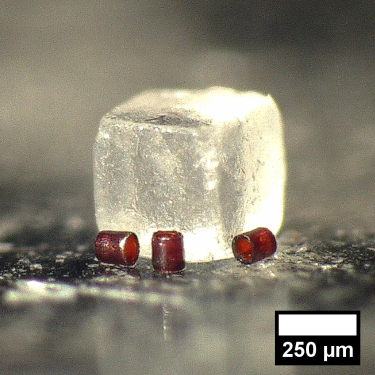Research
Metrology for Magnetic Materials
Magnetic Particle Synthesis and Characterization. I have an interest in creating and characterizing magnetic nano- and micro- particles for a variety of applications.
High-Frequency Metrology for Microelectronics. Within the microelectronics industry, miniaturized magnetic components are being developed to reduce the size, weight, and power of devices. I am developing techniques to characterize these materials.
Magnetic Mapping of Magnetic Nanoparticle Clusters. In collaboration with Professor Gunjan Agarwal's group at The Ohio State University (OSU), I have been exploring the magnetic properties of magnetic nanoparticle aggregates. Man-made iron oxide nanoparticles have widespread importance for labeling cells and molecules. Besides synthetic particles, many organisms also generate naturally occurring iron oxide nanoparticles, known as ferritin, to store and regulate iron within their bodies. Whether man-made or natural, these iron oxide nanoparticles have a magnetization that can be used as a tool for manipulation or sensing in biological environments. However, nanoparticles often aggregate in complex bio-environments, and the effect of aggregation on their collective magnetic properties is not well understood. For this project, I am developing methods to micropattern nanoparticle aggregates with well-defined structural properties. The structure can then be correlated with magnetic force microscopy measurements performed by collaborators at OSU. Findings can be potentially used to engineer magnetism-based tools for tracking iron nanoparticles in biological systems. Also, understanding of the effect of clustering on magnetic properties can enable quantitative histo-magnetic detection schemes for mapping iron deposits in tissue sections.
Sensors and Contrast Agents

Magnetic Sensors. I develop new types of magnetic sensors that can be wirelessly interrogated and used to measure properties like pH and temperature.
Contrast Agents for Low-Field Magnetic Resonance Imaging (LF-MRI). Recently, I have been exploring the properties of iron oxide nanoparticles for applications as LF-MRI contrast agents.
RF-Addressable MRI Sensors. In previous work, Dr. Gary Zabow at the National Institute of Standards and Technology (NIST) and collaborators in the Laboratory of Functional and Molecular Imaging (LFMI) at the National Institutes of Health (NIH) showed that magnetic particles with special shapes could be used as microfabricated multispectral MRI "color" contrast agents and geometrically encoded magnetic sensors (GEMS). One of the special geometries is a magnetic particle shaped like a hollow cylinder.
I have been developing a new type of GEMS that can be produced cheaply using a soft lithographic technique known as micro-molding. Some of these particles are shown in the image on the right (displayed next to a single grain of salt to provide a sense of scale). The particles have a cylindrical-shell geometry that encodes a unique RF signature and can be made of a “smart” polymer that changes shape in response to specified environmental conditions, such as pH. The shape change causes a corresponding, quantifiable shift in the RF-frequency and reports on the microenvironment. This shift is much larger than standard nuclear magnetic resonance (NMR) chemical shifts, producing an unambiguous signal for sensing.

